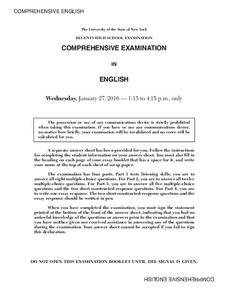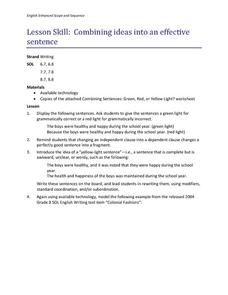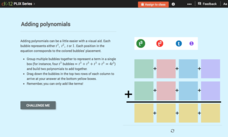Curated OER
Character Analysis and The Crucible
Readers of The Crucible use a SATDO chart to collect evidence they will use to craft interpretive statements and an analysis of one of Miller’s characters. Background information on the play and about Miller, links to handouts,...
Curated OER
Character Traits in Fables
Combining art, music, dance, and reading comprehension, this lesson is geared to reach all ability levels. After reading a variety of fables and discussing story elements and character traits, class members select a moral to use as the...
Fluence Learning
Writing a Narrative: How Bear Lost His Tail
After reading the first, second, and third parts of "How Bear Lost His Tail", third grade writers answer questions about the story by completing a series of options, including discussion points. Then, they begin to plan a new narrative...
EngageNY
Opposite Quantities Combine to Make Zero
Find the cards that get to zero. The activity introduces the class to the idea of adding integers. Pupils use a number line to count up and count down when adding. They play a game to collect cards that will sum to zero.
New York State Education Department
Comprehensive English Examination: January 2016
Poetry and prose often have more in common than it initially appears. A sample comprehensive English exam has test-takers compare and contrast two passages to answer short response questions. The exam, which is part of a larger set of...
Maryland Department of Education
The Concept of Diversity in World Literature Lesson 1: Unit Introduction
To launch a unit study of the concept of diversity in World Literature, class members compare Chinua Achebe's essay, "An Image of Africa: Racism in Conrad's Heart of Darkness" and Richard Rodriguez's essay, "The Chinese in All of...
Public Schools of North Carolina
Math Stars: A Problem-Solving Newsletter Grade 5
Looking for a way to challenge the problem-solving abilities of your young mathematicians? Then look no further. This collect of newsletter worksheets engages learners with a variety of interesting word problems that cover topics ranging...
Curated OER
Reading Review for Grade 5 (5.3)
In this reading review for grade 5 (5.3) activity, student answer 25 multiple choice questions in standardized test format for 7 reading passages.
Curated OER
Combining Syllables to Form 2- and 3-Syllable Words
Students practice combining consonant-vowel-consonant sounds to form words. They read closed and silent "e" syllables. Students construct two-syllable words. They arrange syllables to form three and four syllable words.
Virginina Department of Education
Combining Ideas into an Effective Sentence
Here is a lesson that is best utilized as reinforcement in identifying sentences that combine independent/dependent clauses, and phrases that are awkward, fragmented or complete. Learners use the red, yellow, and green light method...
Curated OER
Voice - 6 + 1 Traits of Writing
Fourth graders combine listening and writing skills in this activity. After listening to Up North at the Cabin, Students are asked to write a piece from a specific viewpoint about a place that they like to visit.
Curated OER
Poems: calligrams
Have fun with shape poems! First and second graders write calligrams that add to the meaning of their poems. Great for your poetry unit or if you want to combine poetry and art lessons.
CK-12 Foundation
Sums and Differences of Single Variable Expressions: Algebraic Soup
Alphabet soup just got an upgrade. Pupils drag expressions from algebraic soup to indicate whether it is a like term to x or to y. Some challenge questions require combining the like terms to simplify expressions.
Curated OER
Express Yourself Lesson Seed 1
Make a study of the First Amendment and its relationship to freedom. Pupils rewrite the amendment and discuss the central idea before focusing on a specific phrase. After discussing, class members write a journal entry about the included...
Scholastic
STEM Challenges and Activity Sheets for Grades 6–8
From 3-D cities to building bridges, young engineers engage in innovative STEM challenges that promote brainstorming and collaboration. Learners take on the roles of different types of engineers as well as become familiar...
Kenan Fellows
Qualitative Kinetics: Examining the Effect of an Enzyme on a Reaction
Scholars learn about kinetics and buffers as they use qualitative and quantitative methods to understand enzyme rates and buffer capacity. The application of Beer's Law and spectrophotometry solidifies pupils' knowledge in the first of...
CK-12 Foundation
Addition and Subtraction of Polynomials: Adding Polynomials
Stack the like terms to add vertically. The resource contains a visual aid to help with the addition of polynomials using the vertical method. Pupils use the aid to calculate the sum of two polynomials.
Curated OER
Grade 1 Phonics- Short a
Work on the short /a/ in phonics lessons. Recognize and identify "Aa," name the letter "A," know the short /a/ sound, rhyme using short /a/ word families, decode basic short consonant-vowel-consonant words and transfer wisdom of the...
Evan-Moor
Daily Handwriting Practice: Traditional Cursive
Keep your class practicing handwriting each day in a 36-week school year with this comprehensive resource that combines daily cursive practice with content such as poetry, geography facts, continents, and much more.
National Geographic
The Monsoon
Few things are as fascinating as the challenge of climbing Mount Everest. This lesson investigates how monsoon weather impacts climbers. To begin, you are instructed to show various video clips. The only one directly provided, however,...
Curated OER
Adding Two Digit Numbers with Using Dimes and Pennies
Second graders participate in a math game using dimes and pennies. They practice combining coins to make a given amount of money, and they use the combinations to practice adding two digit numbers. Teacher assessment strategies and...
California Academy of Science
Discovering Rainforest Locations
How many rainforests are there, where are they, and do global factors effect their locations? These are great questions that have great answers. Children in grades four through eight use several different maps to determine why...
Georgia Department of Education
Exploring Poetry and Poets
Combine the study of poetry and non-fiction texts with this complete and ready-to-use six-week unit. After reading numerous poems from local writers and compiling a personal anthology, high schoolers find and read a memoir or biography...
CK-12 Foundation
Greatest Common Factor Using Lists: Tiling the Kitchen Floor
Use a combination of tiling a rectangle to find area and find the greatest common factor of the lengths of two sides and the area they create. Pupils increase and decrease the sides of the rectangle before answer five questions...























